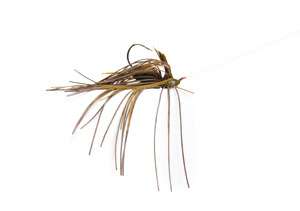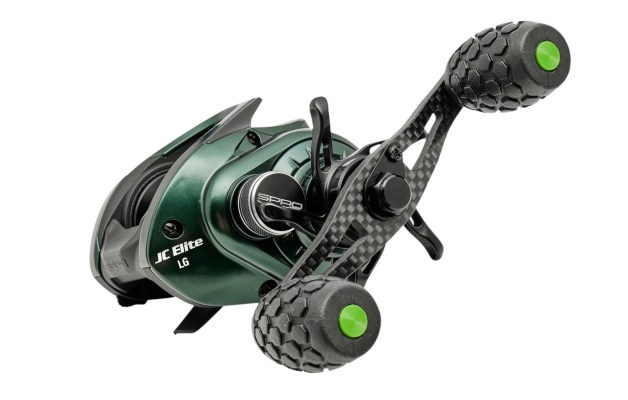
It’s amazing how much life a Bassmaster Tour win can give a unique regional lure.
That’s what happened to Buckeye Lures’ Mop Jig when South Carolina’s Davy Hite used it to win the 2006 Pride of Georgia event at Clarks Hill, Ga.
Once stereotyped as a jig for Southeastern lakes, the Mop Jig has since become a big bass weapon used by anglers nationwide.
Of course, no one had to tell Southeastern anglers just how good this big, ugly jig can be. They had been bagging quality fish with it for nearly a decade before Hite lifted it to national prominence.
“It had a good name locally, and that put it on the map,” notes Buckeye Lures President Jeremy Altman. “As more people outside the Southeast used it, they realized what a great tool it is.”
The jig has 4 to 5 inches of bulky, hand-tied, round rubber skirting, which creates its mop-like presence. But don’t be fooled by its unorthodox appearance, Hite says.
“When you look at it in the package or dangling on the end of your line, it doesn’t look like much,” Hite admits. “But when you put a good trailer on it and drop it into the water, you see what separates it from all other lures and why it’s so attractive to large bass.”
Pause the bait on the bottom, he adds, and the trailer stands up, allowing the Living Rubber skirt to undulate and flare like no others.
“It gets big and fluffy, just like a crawfish or a creature in the defensive mode, and I think that’s why bass attack it,” Hite describes.
At Clarks Hill, he caught big limits on the Mop Jig while other contestants were thrashing the surface with topwaters. Historically, surface baits are preferred at Clarks when blueback herring are spawning around the banks, as they were that week.
However, the cagey Hite, who had dunked his share of jigs in the popular lake over the years, had other thoughts.
“Topwater fishing can be pretty risky business because you lose a lot of fish,” says Hite, who won the event handily. “Guys complained all week about that, but not me. I had a bait they ate.”
Hite says the massive, mop-like skirt is irresistible to big bass and was key to his success. It also was instrumental in his second-place finish at Clarks Hill in 2008.
In fact, the rubber skirt is nearly identical to the one fashioned on the Booyah A-Jig and Pigskin Jig that Alton Jones helped design and used to win the 2008 Bassmaster Classic at Lake Hartwell. Jones’ winning jigs were said to be prototypes at the time, yet the concept likely came from his familiarity with Buckeye Lures’ version.
Drawbacks? Well, this isn’t the jig you reach for when you’re fishing for average bass.
“If you’re out to catch 30 bass, it probably isn’t the right choice, because it’s not a numbers bait,” Altman says. “It catches smaller bass, but generally, it’s a big fish bait.”
Although he cast the jig over rocky points at Clarks Hill, Hite points out that the jig can be deadly when flipped around cover and that it has become popular for swimming around boat docks in the Carolinas.
It’s effective anytime bass are eating jigs, Altman adds, but he says it really shines during the fall or early spring when bass are utilizing offshore humps and structure.
Fellow Bassmaster Elite Series pro Jason Williamson of Aiken, S.C., says the Mop Jig has universal appeal. He credits a second-place finish at Santee Cooper, a 13th at California’s Clear Lake and another second on the Mississippi River to his success with the Mop Jig.
“It’s my confidence bait and what got me through the Bassmaster Opens to qualify for the Elite Series,” he says. “I bet I don’t own 20 jigs tied with silicone skirts. The Living Rubber is that good.
That’s not to say some silicone skirting isn’t used on the Mop Jig. The round rubber that Buckeye purchases from its California source is only offered in three colors: black, brown and white.
To produce color variations, nine to 10 strands of colored silicone skirting are added. The jig is marketed in Texas craw, peanut butter and jelly, black/blue, watermelon red, black chartreuse, brown orange, green pumpkin and solid black or brown.
A key to the active skirt is the way it is tied, Hite says. Wire is wrapped tightly around the throat of each skirt, a feature that helps it flare more.
“Without that, it doesn’t stand out,” he adds.
Mop Jig aficionados urge anglers to resist the temptation to trim the skirt.
“Some people think it’s too big for smaller bass, but it’s not,” Altman explains. “You want that big skirt; it’s the key to the bait.”
Williamson says the head design is integral, too. It’s a rocker style with a flat bottom angled at 45 degrees that helps push the plastic trailer up and give it a natural profile.
The design is extremely versatile, Williamson adds, noting that he fishes it through scattered grass and brush and over rocky bottoms.
“The head stands up whereas a lot of other jigs fall to the side when they’re not being moved,” he explains. “Buckeye is known for that stand-up concept in its Spot Remover leadhead jigs that are very popular for finesse fishing for spotted bass.”
The jig is built with a 5/0 Mustad heavy flipping hook, which means you’d be wise to fish it on a heavy rod and line. Altman suggests a 7-6 rod with a fast tip and 16- to 20-pound fluorocarbon line.
The Mop Jig comes with a pair of rattles on the shank that can be removed if you prefer a more stealthy approach.
“We believe rattles are a mainstay of big jig fishing,” Altman insists.
The stand-up design coupled with the “breathing” rubber skirt and rattles lends itself to a modified deadsticking presentation, he adds.
“We call it ‘limp-shaking,'” he describes. “Shake the jig on a limp line to fluff the skirt and move the rattles without moving the jig. Do that for about 10 seconds and the bass will knock the rod out of your hand.”
Hite’s favorite trailer is the Yamamoto Flappin’ Hog II, a flat-sided creature bait he says helps the jig glide and fall a little more horizontally.
Others say Zoom’s Chunk trailers are good fits.
Altman, for example, says jig trailers designed to thread onto the hook shank can interfere with the hook set on the Mop Jig.
“With the Chunk, you can skin it on the end of the hook and it stays out of the way,” he describes. “That also gets the trailer out behind the long skirt.”
Williamson opts for either the Super or Pro Chunk.
“If they’re biting it good, I use the Super, but if they’re not hanging onto it, I downsize to the Pro Chunk,” he explains.
Williamson also reminds Mop Jig fishermen that the bulky trailer and the long, heavy rubber skirt will slow the fall rate.
“The rubber skirt is thicker, so a 1/2-ounce Mop Jig is going to fall at about the same rate as a 3/8-ounce jig with a silicone skirt,” he describes. “That’s why I rarely use anything lighter than the 1/2-ounce Mop Jig.”
IT’S ALL IN A NAME
During the 2006 Elite Series tournament on Clarks Hill, eventual winner Davy Hite showed roommate Kevin VanDam his secret lure made by Buckeye Lures of Martinez, Ga.
“I called it a Buckeye Jig, but it was officially known at that time as the ‘Heavy Living Rubber Jig,'” recalls Hite.
But when VanDam saw the monster jig’s long bulky skirt, the Kalamazoo, Mich., pro laughed.
“You don’t trim that thing? It looks like a mop!” he joked, unknowingly giving the lure a new name.
The Mop Jig, offered in four sizes and nine skirt colors, sells for around $4.29 at most retailers. For more information, visit www.buckeyelures.com.
CUSTOM ‘MOPS’
Want to dress your favorite jig with a Mop skirt? Buckeye Lures will tie its standard-color skirts on your favorite jigs if you send the baits to the company.
Prices vary but run about $2 per jig, and you pay the shipping both ways.
For details, call Buckeye at 866-GOBUCKEYE.





